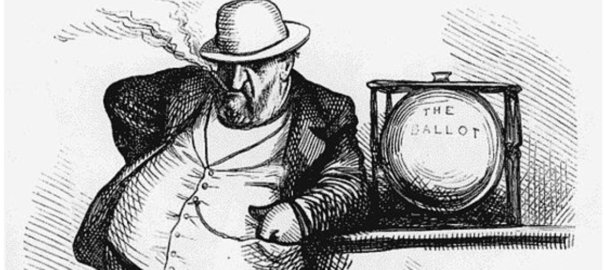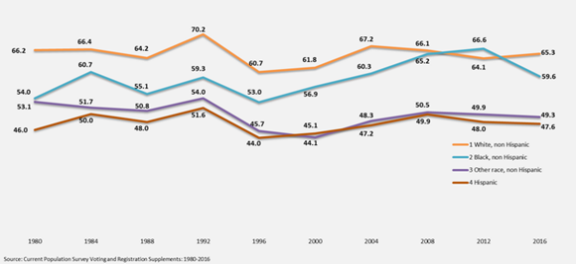[Headline graphic: As long as I count the Votes, what are you going to do about it? A caricature of Boss Tweed by Thomas Nast in Harper’s Weekly, 1871. (This work is in the public domain in its country of origin.)]
By Kent R. Kroeger (Source: NuQum.com; October 20, 2020)
Over the past four years, the news media’s central, animating trope about Donald Trump has been accusations over his lying.
At least 66 more lies and misleading claims were uncovered over the weekend, according to a CNN report.
Admittedly, Trump’s willingness to spread unverified rumors does not help his reputation for honesty (Sorry, Mr. President, but there is, as yet, no irrefutable evidence that Hunter Biden pocketed a $3.5 million check from a Russian billionaire—though some genuinely inquisitive investigative reporting on that accusation and other Hunter Biden financial windfalls would be a refreshing chance of pace.)
However, scratch the surface of most of those 66 “lies” and we find that there is usually actual substance behind Trump’s words–even when the specific facts he cites are questionable.
The partisan dispute over the risks of mail-in voting is a prime example.
This weekend in Georgia, Trump told a crowd of supporters that mail-in voting was vulnerable to fraud, particularly in the nine states and District of Columbia where “unsolicited” ballots are allowed to be sent to all eligible voters. In Trump’s words, such ballot distribution methods are a “big con job” meant to encourage vote fraud.
CNN “fact-checkers” quickly slapped down Trump’s claim by noting that “fraud is exceedingly rare in U.S. elections — whether with in-person voting, mail voting in states where voters have to request ballots or mail voting in states where all eligible registered voters are sent ballots without having to make requests.”
But CNN’s fact-check claim is fraught with its own accuracy problem. Proven mail-in vote fraud, while rare, is hardly non-existent and one of its most egregious examples from a 2018 North Carolina congressional election stands as testament to how mail-in voting’s weaknesses can be exploited, even when limited “ballot harvesting” is allowed by state law.
“Ballot harvesting” is a process in which third parties with a potential stake in the election outcome gain unsupervised access to voters and their absentee ballots.
Yes, the accused in that North Carolina case, L. McCrae Dowless Jr., was a Republican operative whose stunningly reckless absentee vote tampering activities were well-documented by North Carolina state elections investigators and by The New York Times. But 18 other absentee voting fraud convictions have also occurred in the U.S. since the 2016 election, according to The Heritage Foundation’s Voter Fraud Database, which contains 1.298 proven cases of voter fraud occurring between 1979 and 2020. Relative to the total number of votes in those elections, the number of fraud cases is tiny. But the Heritage database nonetheless disproves any suggestion that mail-in vote fraud is non-existent or impossible.
However, it is not overt vote fraud that Trump and the Republicans are most afraid of in 2020—it is mail-in voting’s legal forms of vote-biasing that scares them. For example, systematically mailing multiple absentee ballots to some household types as opposed to others could significantly alter the composition of the voting electorate, which affects election outcomes. [I’ve already received two absentee ballots from the State of New Jersey. What could possibly go wrong with this approach to boosting voter turnout?]
Perhaps it takes a career survey researcher sensitive to response bias to recognize this feature of mail-in voting, but that is why this vote method most likely helps the Democrats in the current context. Mail-in voting disproportionately increases the chances of voting by previously low-turnout constituencies as it significantly reduces the effort required to vote.
What is wrong with that? Nothing, in my opinion, unless the vote choices made by mail-in voters are disproportionately influenced by those seeking and collecting those votes.
Historically, some of the Democrats’ most loyal constituencies generally register and turnout for elections at much lower rates than the typical Republican constituency (see Figure 1 below). Regrettably, but not surprisingly, the Republicans have done everything in their legal power to encourage these low turnouts (e.g., voter roll purges, increased barriers for voter registration, gerrymandering). Equally unsurprising, the Obama presidential campaigns most notably seized upon the potential for absentee (early) voting to lift those low response rates. Their belief that Democrats would be in a far superior electoral position than Republicans if Blacks and Hispanics voted at rates similar to whites is supported by the numbers.
Figure 1: Reported Voting Rates by Race and Hispanic Origin: 1980-2016 (Source: U.S. Census Bureau)
Prior to the current century, absentee voting was largely the domain of military members, the elderly and white, affluent Americans (i.e., people who are home-bound, live overseas or travel frequently), but with the John Kerry and Barack Obama campaigns, the Democrats increasingly pursued a Get-Out-The-Vote (GOTV) strategy that placed more emphasis on absentee (early) voting over traditional in-person voting. To do that, they dramatically increased voter registration efforts and aggressively encouraged likely Democratic voters to apply for absentee ballots (in states where that was necessary). Every vote already counted as an absentee vote meant more money could be targeted late in a general election campaign on undecided and independent voters. The strategy worked in Obama’s two presidential elections (see the Black vote turnout in Figure 1)—though it failed to help down-ballot Democrats as much as expected.
Relevant to the current debate on mail-in voting, the Democrats’ increased preference for absentee voting does not require “vote-buying” or other types of ballot fraud to be effective, even if that voting method has fraud vulnerabilities not inherent to in-person voting. But going hand-in-hand with mail-in voting, unfortunately, is “ballot harvesting” where the potential increases for election outcomes to be determined by the organizational skills (and funding) of party apparatuses rather than by the genuine will of the people.
The 2020 election is all but lost for Trump and the Republicans, but we should prepare for a mail-in voting arms race in future elections. And if what’s past is prologue (such as the election use of TV advertising, direct mail, micro-targeting, “Big Data” analytics), expect the Republican Party machine to become every bit as effective as the Democrats in exploiting mail-in voting and “ballot harvesting.”
It is a competition that I fear will do little to make our elected representatives more responsive to constituents’ interests but do a lot to ensure that the large donors who fund these mail-in and vote harvesting operations will maintain their stranglehold over U.S. public policy.
- K.R.K.
Send comments to: nuqum@protonmail.com

